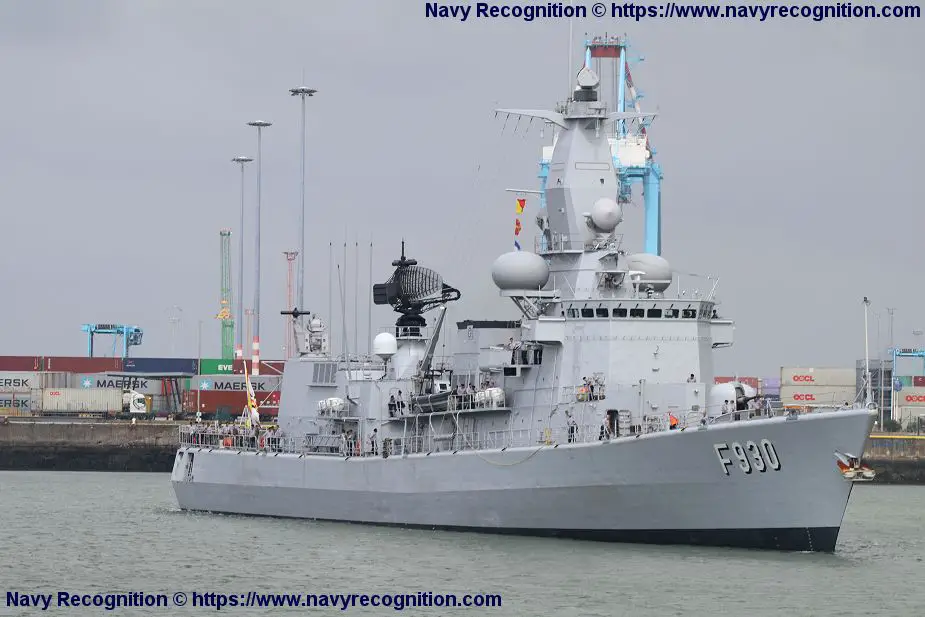Breaking news
Departure for Belgian Navy frigate Leopold I F930 to SNMG1 Standing NATO Maritime Group One mission.
Friday, August 2, 2019, the editorial team of Navy Recognition was in the Naval military base of Zeebrugge in Belgium to cover the departure of the Belgian Navy frigate Leopold 1 (F930) for its departure to the mission SNMG1 (Standing NATO Maritime Group One) which will last 4 months.
 Departure for the Belgian Navy frigate Leopold to the SNMG1 Standing NATO Maritime Group One mission, August 3, 2019. (Picture source Navy Recognition)
Departure for the Belgian Navy frigate Leopold to the SNMG1 Standing NATO Maritime Group One mission, August 3, 2019. (Picture source Navy Recognition)
Standing NATO Maritime Group One (SNMG1) is one of NATO's standing naval maritime immediate reaction forces. Prior to 1 January 2005 it was known as Standing Naval Force Atlantic (STANAVFORLANT). The group was also briefly called the Standing NATO Response Force Maritime Group One. The SNMG1 consists of four to six destroyers and frigates. The force operates, trains and exercises as a group, providing day-to-day verification of current NATO maritime procedures, tactics and effectiveness
The SNMG1 2019 under the command of U.S. consisting of five nations that includes United States with the USS Gridley (DDG-101) Arleigh Burke-class destroyer, Belgium with the Leopold I (F930) Karel Doorman-class frigate, Norway with the Thor Heyerdahl (F314) Fridtjof Nansen-class frigate, Netherlands with the Van Speijk (F828) Karel Doorman-class of multi-purpose frigate and Portugal with the Francisco de Almeida (F334) former Karel Doorman frigate.
The Belgian Navy, officially the Belgian Maritime Component of the Belgian Armed Forces, formerly the Belgian Naval Force, is the naval service of Belgium. In times of crisis and war the Belgian Navy will manage, with the support of its allies, the crises rising from the infringements to the principles of International law and/or from the Humans right and exercise the Belgian sovereignty in the maritime zones where the Navy is qualified, defend the lines maritime of communication, main roads and allied, and protect the ports against any air, surface or underwater attack.
The Naval Component of the Belgian armed forces has two core capabilities - escort operations and mine countermeasures (MCM) - and consists of two frigates, five mine hunters and one command & support ship, all located in the Belgian naval base in Zeebrugge. The Naval Component is able to deploy one frigate for two periods of six months, as well as, in the framework of an MCM-group, four minehunters and its command & support ship for up to six months, or two mine hunters on a permanent basis.
The Leopold I (F930) is a Karel Doorman-class frigate of the Marine Component of the Belgian Armed Forces. It is one of the two frigates of this class purchased from the Royal Netherlands Navy on 22 December 2005. This frigate has a crew of 145 people including 15 officers, 70 NCOs an 60 sailors. Its armed with 16 RIM-7 Sea Sparrow anti-air vertical launching system, 8 Boeing Harpoon anti-ship missiles, 6 FN MAG 7.62mm machine gun, 2 Twin-Mark 46 Torpedo tubes, 1 OTO Melara 76mm gun and 1 Goalkeeper CIWS close-in weapon system 30mm cannon. The rear deck of the frigate can accommodate one helicopter Alouette 3 and in the future the NH-90.
Belgian and Netherlands have launched the Future Surface Combatant project to replace the existing fleet of frigate. The new frigates will be delivered to the Belgian Navy between 2027 and 2030.


























